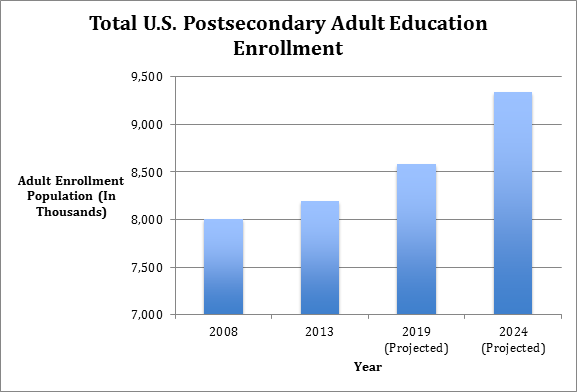With summer beginning to wind down, thousands of Mainers are getting ready to go back to school. This September, Maine’s post-secondary schools—colleges, universities, and community colleges across the state—are preparing for an influx of students as Maine’s high school graduation rate continues to climb upward. But as the images of wide-eyed, young, and eager freshman dominate commercials for the Best Buy, The GAP and U-Haul Rentals, it is time to recognize one of the largest and fastest growing student populations returning to school this fall: adults.
The number of students under 25 years old pursuing a degree continues to rise in many states, but more telling is the recent increase in the number of students older than 25 either returning to school or enrolling for the first time (see graph). The National Center for Education Statistics projects that by 2024, over nine million adults will be enrolled in some form of post-secondary education. Increasingly, adults can no longer support themselves and their families with a high school education alone.
Source: National Center for Education Statistics, Digest of Education Statistics: 2014, Total fall enrollment in degree-granting post-secondary institutions, by attendance status, sex, and age: Selected years, 1970 through 2024
As the demand for adult higher education increases, it is time for Maine to start providing the resources needed to assure that these adults can succeed. According to a recent poll that looked into factors that influence adult enrollment, convenience in class location and time, availability of financial assistance, relevance to current or potential job, and course flexibility were some of the most important factors influencing adults returning to the classroom.
Maine specifically can and should be doing more to make post-secondary education for adults more easily attainable as 55 percent (data file) of Mainers age of 25-54 have only a high school diploma or have some post-secondary education experience but no degree. Minorities in Maine equally need access to post-secondary education as 48 percent (data file) have only a high school diploma with possibly college credits but no degree.
Maine is not alone. The growing demand for adult post-secondary enrollment comes at a time when nearly 47 million workers nationally between the ages of 25 and 64 have a high school diploma but no college, and 17 percent of all working age adults have some post-secondary experience but never finished their degree.
So how can we help? To begin Maine should look to states like Florida, Tennessee, New York, New Jersey, and Washington that have passed legislation to provide adults seeking post-secondary education greater flexibility to obtain their degrees. Further, by increasing the minimum wage, expanding Internet availability, and providing better institutional assistance, Maine can provide a framework to make post-secondary education more affordable and accessible.
As our labor market modernizes, it is necessary for more and more adults to pursue post-secondary education. By taking crucial steps to make post-secondary education more attainable for adults, Maine will be facilitating one of largest new education and workforce movements, while making one of the most crucial investments toward a robust economic future.
Maine needs an educated workforce to attract the kinds of jobs that will assure greater prosperity for all Mainers. Thousands of adults are eager for that opportunity. It is time for Maine to help send everyone who aspires to succeed back to school.



